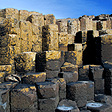DUNLUCE
CASTLE
Dramatic Coastal Ruins of Antrim
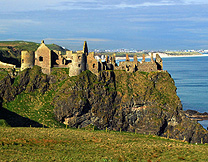 Dunluce Castle stands on a tower of black basalt, 90 feet above the roiling sea below, ruined jagged walls like a ghostly inhabitant of a Gothic thriller, or smugglers’ sea adventure. Located along the Antrim Coast drive between the village of Bushmills, known for its Irish Whiskey distillery (see Old
Bushmills Distillery Tour) and the famed Royal Portrush Golf Course, the castle ruin, perched on its spear of land has been the subject of many a painter, especially for its most dramatic outline above the chalk cliffs from the eastern approach.
Dunluce Castle stands on a tower of black basalt, 90 feet above the roiling sea below, ruined jagged walls like a ghostly inhabitant of a Gothic thriller, or smugglers’ sea adventure. Located along the Antrim Coast drive between the village of Bushmills, known for its Irish Whiskey distillery (see Old
Bushmills Distillery Tour) and the famed Royal Portrush Golf Course, the castle ruin, perched on its spear of land has been the subject of many a painter, especially for its most dramatic outline above the chalk cliffs from the eastern approach.
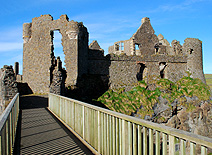 The earliest medieval fortress on the spot was most likely built be Richard De Burgh under the Anglo-Norman rule of Ireland (see King
Johns Castle), though some defense probably occupied it since Celtic times. The outer castle walls of the current castle date back to the 14th Century and the time of the MacQuillans who controlled the trade routes along the North Antrim coast between the Bann and Bush Rivers. Most of the remains of the castle buildings as seen today are from 16th and 17th Centuries when the north coast of Ulster was in the hands of the MacDonnells. The MacDonnells were an offshoot of the Scottish clan of the McDonald, known as the Lords of the Isles, that part of Scotland closest to the coast of Northern Ireland. The headlands of Scotland are so close to the Irish shore it raised the legend of Finn MacCool and the nearby Giant’s Causeway (see Giant’s
Causeway).
The earliest medieval fortress on the spot was most likely built be Richard De Burgh under the Anglo-Norman rule of Ireland (see King
Johns Castle), though some defense probably occupied it since Celtic times. The outer castle walls of the current castle date back to the 14th Century and the time of the MacQuillans who controlled the trade routes along the North Antrim coast between the Bann and Bush Rivers. Most of the remains of the castle buildings as seen today are from 16th and 17th Centuries when the north coast of Ulster was in the hands of the MacDonnells. The MacDonnells were an offshoot of the Scottish clan of the McDonald, known as the Lords of the Isles, that part of Scotland closest to the coast of Northern Ireland. The headlands of Scotland are so close to the Irish shore it raised the legend of Finn MacCool and the nearby Giant’s Causeway (see Giant’s
Causeway).
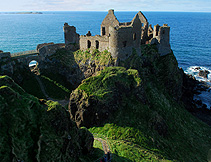 The
castle changed hands a number of times among the fighting family, principally symbolized by the rowdy and wild, Sorley Boy MacDonnell. In 1584, Sir John Perrot, the Lord Deputy of Ireland, raided the castle, which he took easily because he had brought three cannons, against which the old stonework castle walls could not defend. Two years later, Queen Elizabeth returned the castle to the family. When the Spanish Armada ship-of-the-line, the Girona, ran aground on the nearby rocks (see Derry Tower Museum), Sorley Boy was
able to salvage three of his own cannons from the ship wreck.
The
castle changed hands a number of times among the fighting family, principally symbolized by the rowdy and wild, Sorley Boy MacDonnell. In 1584, Sir John Perrot, the Lord Deputy of Ireland, raided the castle, which he took easily because he had brought three cannons, against which the old stonework castle walls could not defend. Two years later, Queen Elizabeth returned the castle to the family. When the Spanish Armada ship-of-the-line, the Girona, ran aground on the nearby rocks (see Derry Tower Museum), Sorley Boy was
able to salvage three of his own cannons from the ship wreck.
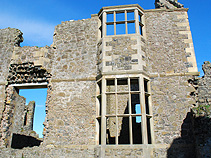 When
James VI of Scotland became James I of England, the MacDonnells were
favored loyal kinsmen and granted the lands of the Glens and coast
of Antrim (see Londonderry Arms Hotel). In 1620, the English king required all his earls in Ulster to build a castle on their baronies and Sir Randal MacDonnell set about to improve and expand Dunluce Castle with the addition of a new manor house and quarters. It was only a few short years before misfortune fell. Part of the lower kitchens fell into the sea one night in 1639 during a grand dinner party, and in 1651, the belongings of the family were seized by agents of Oliver Cromwell. The family went into exile during the Cromwellian years and after the Restoration, virtually abandoned the castle. The castle was granted to the Northern Ireland government in 1928.
When
James VI of Scotland became James I of England, the MacDonnells were
favored loyal kinsmen and granted the lands of the Glens and coast
of Antrim (see Londonderry Arms Hotel). In 1620, the English king required all his earls in Ulster to build a castle on their baronies and Sir Randal MacDonnell set about to improve and expand Dunluce Castle with the addition of a new manor house and quarters. It was only a few short years before misfortune fell. Part of the lower kitchens fell into the sea one night in 1639 during a grand dinner party, and in 1651, the belongings of the family were seized by agents of Oliver Cromwell. The family went into exile during the Cromwellian years and after the Restoration, virtually abandoned the castle. The castle was granted to the Northern Ireland government in 1928.
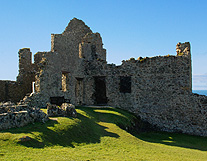 The castle can only be reached across a bridge from the mainland courtyard and visitors center. A 10 minute film about the castle’s history begins a visit. Originally, the bridge was a rickety wooden structure which could be broken under attack, making the castle nearly impregnable during the Middle-Ages. Later the crossing of the rocky 30 meter deep gap was supported by a stone arch. The oldest parts of the castle defenses are the outer wall and two round towers, with the Scottish-style gatehouse added a bit later. The row of columns running parallel to the east gate is known as a Loggia, framing a formal garden from the Elizabethan era. The rest of the roofless building walls remaining are from the 1600’s, including a Great Hall with two fireplaces and three bow windows, a pantry, buttery and kitchen with a huge fireplace. A manmade tunnel running under the north east tower, opening out onto the cliff, dates back a thousand years to the earliest structure on the site. Back across the bridge on the sloping landward approach is where the 17th Century visitors' lodgings, stables and the Earl’s gardens stood. For more photos see Favorite Castles in Ireland and Northern Ireland.
The castle can only be reached across a bridge from the mainland courtyard and visitors center. A 10 minute film about the castle’s history begins a visit. Originally, the bridge was a rickety wooden structure which could be broken under attack, making the castle nearly impregnable during the Middle-Ages. Later the crossing of the rocky 30 meter deep gap was supported by a stone arch. The oldest parts of the castle defenses are the outer wall and two round towers, with the Scottish-style gatehouse added a bit later. The row of columns running parallel to the east gate is known as a Loggia, framing a formal garden from the Elizabethan era. The rest of the roofless building walls remaining are from the 1600’s, including a Great Hall with two fireplaces and three bow windows, a pantry, buttery and kitchen with a huge fireplace. A manmade tunnel running under the north east tower, opening out onto the cliff, dates back a thousand years to the earliest structure on the site. Back across the bridge on the sloping landward approach is where the 17th Century visitors' lodgings, stables and the Earl’s gardens stood. For more photos see Favorite Castles in Ireland and Northern Ireland.
Visiting Dunluce Castle
The castle is open daily all year round, from April to September 10am to 6pm, and from October to March 10am to 5pm. Last admission is a half-hour before closing. Admission prices are £5 for adult £3 Consession and children under 16, children under 5 years are free. There is a family ticket for £13. Guided tours are available with advance booking. When the castle is closed, you can still walk down the steps, past the wishing well and mermaid’s cave to the coastal rocks. The ruins of St. Cuthbert's Church are a short walk from the castle grounds - on the small road opposite the Portrush entrance to the castle. © Bargain Travel Europe
Find best travel deals in Northern Ireland on TripAdvisor
Web
Info
Dunluce
These articles are copyrighted and the sole property of Bargain Travel Europe and WLPV, LLC. and may not be copied or reprinted without permission.
SEE ALSO:
DRIVING
SCENIC IRELAND
CARRICK-A-REDE ROPE BRIDGE
COOKING
HOLIDAYS IN IRISH CASTLES
ARMAGH PUBLIC LIBRARY & VICAR’S HILL No 5
CASTLE COOLE & FLORENCE COURT MANOR
GAME OF THRONES LOCATIONS TOUR

